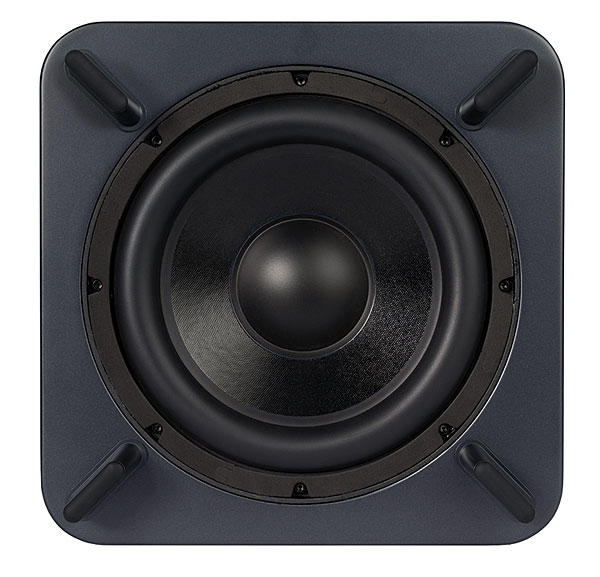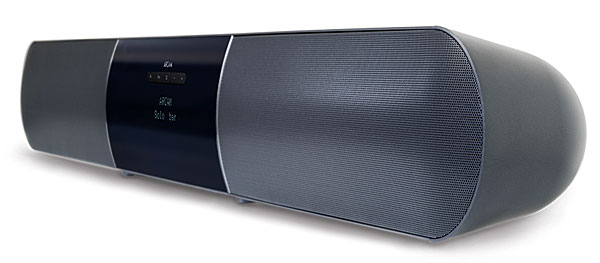Arcam Solo Soundbar System Review Page 2
Snowpiercer is the story of a train that holds the only remaining vestige of human life in a world plunged into a climate-catastrophe deep freeze. Here is where I missed conventional discrete surround effects. The 2.1-channel presentation, even in Movie mode, didn’t even attempt to convey the wraparound sound of “the rattling ark.” Usually, I’d prefer good stereo over bad faux-surround, but this was an exception.
The Comfy Chair
I listened to many hours of music in various modes, with original room EQ, updated EQ, and no EQ. My eventual preference for music was the Stereo mode, which added detail; room EQ off, which reduced detail; and the sub gain set to 60 percent of maximum. Those settings apply to most of the following notes. Overall, this was a warmer sound, allowing me to run the system at higher but still comfortable levels.

King Crimson’s Live at the Orpheum was the one piece of music I listened to in every possible configuration, using Tony Levin’s tasty bass lines on “The ConstruKction of Light” for subwoofer fine-tuning. Blending between the bar and sub was excellent, even with the sub operating at a higher volume. And the way the bar lifted Mel Collins’ flute and sax solos above the mix, like fluttering birds, had me replaying the track time and again. It also made Robert Fripp’s shredding chorded guitar solo on “Sailor’s Tale” a thing of shimmering metallic beauty (and psychosis).
I auditioned Brahms’ Piano Concerto No. 2 via the historic RCA Living Stereo recording from 1960 by Sviatoslav Richter, Erich Leinsdorf, and the Chicago Symphony Orchestra (available as a separate CD or in Richter’s new Complete Album Collection box from Sony Classical). It was a perfect storm of texture, layering, and dynamics. The biamplification delivered not only the Chicago’s macrodynamics—the sound of the archetypal big, confident American orchestra—but also Richter’s numerous microdynamic shadings and nuances. While the bar didn’t transcend its width (angled tweeters or no), it did summon up enormous concert-hall depth. And the imaging on the third movement’s solo cello part was ravishingly beautiful. Both the Stereo and Concert modes produced excellent results, though I still preferred the former’s marginally greater focus.

Johnny Hartman’s Songs from the Heart partners the singer with a quartet including pianist Ralph Sharon (better known for his work with Tony Bennett) and trumpeter Howard McGhee. Most soundbar systems would force an uneven division of Hartman’s magnificent jazz baritone between bar and sub. But partly due to the 85-Hz crossover, the voice wasn’t localized in the sub at all, though the sub did earn its pay with the string bass lines.
When the official album gave way to the repetitive bonus tracks, I turned down the volume, left my listening position, and sat down at my computer across the room to check e-mail. Then came the final revelation: Once I was no longer looking at the bar, it no longer sounded like a bar (even a good one). The bar and its sub sounded like a decent little component system. This lured me back across the room, where I turned up the volume and listened with my eyes closed. Sure enough, as soon as the visual component was cut off, I knew I was listening to a real audio system.
One for the Road
Following the software update, I ran the movie and music clips on the 2013 DTS Demo Disc. With the sub unyoked from the room correction, the forest flames in The Hunger Games were more full bodied, and bass effects in other movies were similarly more substantial and satisfying. Music with a rhythm section came to life, too, especially the monster beat in Queen’s live “Another One Bites the Dust.”

The Arcam Solo Bar is that rarity: a soundbar that sounds like music. The equivalent excellence of the Solo Sub, liberated from room correction, is even rarer. If you’ve got the cash, this is a soundbar system actually worth listening to.
Editor’s Note: Readers looking at our frequency response measurements and reading our reviewer’s subjective comments should be aware that the Solo, as confirmed by Arcam, was intentionally voiced after extended listening sessions with the severe mid-to-high-frequency roll-off evident in our published response trace (see Test Bench). According to a company rep, “Soundbars are a very tricky compromise that we feel most manufacturers get wrong, going for too much exaggerated ‘boom and tizz,’ which is immediately impressive in-store but results in products that are very tiring to listen to over any period.
“Ninety-nine percent of all movie (and music) info is carried in the 100 Hz to 3 kHz region,” he went on, “and when we tried a very flat response above this, everything got too zingy and nasty.”
This seems like a reasonable approach from a company with deep audiophile roots for what is intended to be a product for everyday non-audiophile consumers, and Mark Fleischmann’s favorable experience with a variety of content would seem to bear out the Solo’s eminently listenable character. But such skewed results in the lab inevitably throw us into a gray area in terms of ratings and Top Pick status—as it did in our May issue when we discovered an intentional 80-Hz spike built into the PS Audio Sprout integrated amp/DAC that is intended to add fullness to the small speakers the manufacturer expects it to be used with. Under traditional protocol, any product that measured alarmingly far from what we’ve always deemed the ideal flat response would be penalized for poor engineering and denied TP status. And I do question why unorthodox decisions like these are delivered to users as a fait accompli, with no option to simply switch from the factory’s preferred default to a more conventional response curve.
That said, I think products should be reviewed in the context of their intended audience and that ultimately the ears of our trusted and very experienced reviewers have final say for audio gear. If they hear but aren’t bothered by some offbeat voicing or EQ (subtle or otherwise), or perhaps find it engaging, there may be reasonable justification for it— particularly among these newer “lifestyle” products like soundbars and amp/DACs, where it can be argued that the old rules may not always apply. So perhaps the best we can do as consumer advocates in these situations is to follow the reviewer’s subjective commentary in terms of a recommendation, report what we find on the test bench, and provide the context as I’ve done here.—Rob Sabin






















































